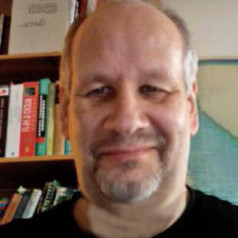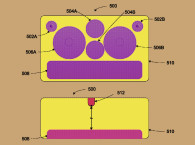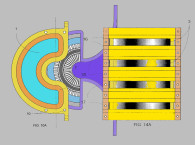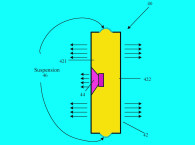
Passive Radiator with Dynamically Adjustable Resonant Frequency
Patent Publication Number: US20170105065A1
Inventor: Joseph F. Pinkerton (Austin, TX)
Assignee: Clean Energy Labs, LLC
Filed: October 10, 2016
Current CPC Class:
Published: April 13, 2017
Patent Abandoned
Number of Claims: 18
Number of Drawings: 4
Abstract from Patent
An audio speaker having one or more passive radiators, and more specifically, an audio speaker having a passive radiator with dynamically adjustable resonant frequency. The audio speaker can dynamically adjust the resonant frequency of its passive radiator so that it lines up with the main bass note frequency (or frequencies) of a given song.
Independent Claims
1. An audio speaker system comprising: (a) an active driver; (b) a memory element; (c) a passive radiator having a resonant frequency; and (d) an actuator operable to dynamically adjust the resonant frequency of the passive radiator.
8. A method comprising: (a) receiving an audio file in an audio speaker system comprising an active driver and a passive radiator that has a dynamically adjustable resonant frequency; (b) storing the audio file in a memory element of the audio speaker system; (c) transmitting an electrical signal to an active driver in the audio speaker system; (d) creating a time delay between the step of receiving the audio file and the step of transmitting the electrical signal to an active driver; and (e) adjusting the resonant frequency of the passive radiator to control the resonant frequency of the passive radiator.
17. A method comprising: (a) analyzing a first part of an incoming audio file; (b) matching the incoming audio file to a song; (c) retrieving parts of the song from a memory module; and (d) dynamically adjusting a resonant frequency parameter of a passive radiator of an audio speaker system comprising an active driver and the passive radiator to enhance primary bass notes of the song.
Reviewer Comments
About 15 years ago, based on some proof-of-concept work I had done with active program-dependent vent tuning, I put forth a suggestion/challenge to our readers during the writing of a Voice Coil patent review. I challenged readers to develop a bass reflex system that would have a real-time variable tuning frequency by dynamically varying the acoustic mass of a vent or passive diaphragm radiator coordinated with the low-frequency band of greatest program signal amplitude. This would enable the active woofer to have reduced excursion capability throughout a wider band of frequencies than a conventional fixed frequency bass reflex system.
The first such system appeared in European patent WO2006/043215, “Vented Loudspeaker Box System and Its Control Method,” by Stephan Willems and assigned to Philips Electronics, comprising a program content analyzer in combination with a motorized vent length controller to vary acoustic mass resulting in the adaptation of the tuning frequency to the spectral region of greatest signal amplitude. Due to problems with motor noise and complexity costs, additional passive techniques for varying acoustic mass by way of changing vent length were explored and disclosed in WO2009/118677, “Vented Loudspeaker System,” by the prolific team of Ronaldus Aarts, Joris Nieuwendijk, and Okke Ouweltijes, also assigned to Philips Electronics. These systems were apparently found to be impractical, as the patents were eventually abandoned.
A new, more recent effort to develop this type of variable tuning frequency (FB) type system has been disclosed in the current patent under review, as an apparent offshoot of the technology development at Clean Energy Labs, whose primary focus has been on various forms of high-efficiency actuators, sensors, and micro-switches. They have recently adapted some of their technology to the loudspeaker realm, including new actuated membrane micro-pump based loudspeaker transducers under the brand name Brane Audio. An additional development, and subject of this patent review, is a bass reflex loudspeaker using a tuning frequency adaptive passive diaphragm radiator, as an alternative to the Philips adaptive vent system, described earlier.
The invention disclosed is that of a passive radiator, bass reflex loudspeaker system that can dynamically adjust the resonant frequency of its passive radiator so that it is coordinated with the most amplitude-significant bass note frequency (or frequencies) of the program material being reproduced.
As an example, Figure 1 shows the frequency spectrum of the song “Dark Horse” by Katy Perry, illustrating a very strong energy peak at approximately 58 Hz. The invention adjusts the stiffness or mass of the passive diaphragm radiator so that the reflex tuning frequency will equal 58 Hz at this particular point in time during the song.

The loudspeaker will typically receive the program signal and apply a delay to it (on the order of 10 to 100 ms) before it is reproduced by the system, providing the tuning frequency controller with a look-ahead ability to determine the dominant program bass note (or notes) before making adjustments to the passive radiator (changing compliance, mass, or both) so that by the time the dominant bass note is reproduced by the loudspeaker, the tuning frequency of the passive diaphragm radiator will be aligned with the peak energy frequency of the program material. This amount of delay may not be compatible with many latency-dependent installations.
The elements of the loudspeaker system are an active driver, a memory device, a passive radiator having a variable resonant frequency, and an actuator operable to dynamically adjust the mass or the compliance of the passive radiator.
Implementation of the invention can include either one or both of a piezoelectric actuator operable to vary the mechanical compliance of the passive radiator suspension; or a liquid mass adjustment actuator to vary the mass of the mobile portion of the passive radiator. For the change compliance function, as shown in Figure 2, the piezo-actuators are set up to stretch at least a portion of the compliant surround member or additional compliant members attached to the surround, so as to stiffen them (reduce compliance and raise the tuning frequency) or to compress the compliant members so as to relax them (increase compliance and reduce the tuning frequency). This can be rapidly achieved, operating substantially at the audio rate of low-frequency signals.

For the piezo compliance change approach, the system can adjust the passive radiator’s resonant frequency toward the resonant frequency determined during the step of analyzing, wherein the step of adjusting compliance corresponds in time to the transmission of the electrical signal to the active drive unit for each of the main bass notes.
For the change of mass function, speaker 400 has a liquid pump 401 that forces a liquid through a tube 402 and in or out of a reservoir 403 that is attached to the passive radiator 201. A controller 404 can determine how much fluid/mass is needed in the reservoir 403 to reach a desired tuning frequency of the passive-radiator to correspond favorably with the spectral content of the program material.
The rate of change of a fluid based mass change is much slower than the electrical activation of the compliance changing piezo elements. So, even though a mass-based change is preferable from a system bandwidth-efficiency standpoint, it can only be operated at the change rate of the general envelope of the audio signal, instead of a more rapid, real-time, signal-tracking rate.
Corresponding to the limitations of the fluid-based, mass change approach, it is stated the operational method can include analyzing, during the time delay, at least part of the program material, to determine the resonant tuning frequency that optimizes the average amplitude of multiple main bass notes present in part of the audio file. This would operate more on the basis of matching the time varying envelope of the program, instead of on a note-by-note basis.
The system would appear to have interesting potential, but the disclosure in the patent is rather meager and doesn’t address the many pitfalls and opportunities that come with this concept. The inventor states that he wishes to have the adaptation in tuning frequency to increase/maximize the output at the new tuning frequency corresponding to the large bass signal frequencies. But, changing tuning downward in frequency will reduce output at the tuning frequency, and the system would require a separate, correspondingly adaptive equalization system to maintain the target amplitude at all times. This is not addressed in the patent, and the description implies that the amplitude is optimized merely by the change of tuning frequency.
The real reason one wishes to track the program peaks with adaptive tuning frequencies, is that it enables the active driver to have substantially reduced excursion during high displacement audio signals, an advantage that appears to be lost on the inventor.
Another concern is that while the compliance-based approach is fast, it is also inefficient at changing tuning frequency and creates an inefficient system output as compliance is reduced. Passive radiators with low compliance ratios will tend to have a notch in the low-frequency response, reducing output at the tuning frequency and creating a steeper slope below the FB (see Richard Small, “Passive Radiator Loudspeaker Systems Part I: Analysis and Part II Synthesis” Audio Engineering Society Journal, October and November, 1974). Additionally, when compliance is increased to the point where losses are minimized, the required change in compliance to shift system tuning-frequency is substantial and possibly not realizable for anything beyond a limited change of a few hertz.
Unfortunately, while the mass change approach is more efficient from a system performance standpoint, the fluid-based realization of the mass change may not be able to achieve a useful rate of change, even for tracking the generalized envelope of the audio signal.
That said, this type of system still has the potential to be useful and the incentive to realize its full capability is significant. At approximately 0.8 × FB and 1.4 × FB bass reflex systems reach their maximum in-band excursion, and those are the frequency ranges that limit the maximum system output to at least 6 dB less than at the tuning frequency (FB). So, if one can manipulate the tuning frequency over a one-octave range, one could realize at least a 6 dB large signal advantage over conventional bass reflex systems. Multi-tuned bandpass systems may have even greater ability to adapt and achieve additional gains.
As often is the case, the inventor of this patent will be refining the system further as real systems are being developed, and in doing so they will discover improvements and new ways to address many of the remaining problems. Stay tuned. VC
This article was originally published in Voice Coil, June 2017.






